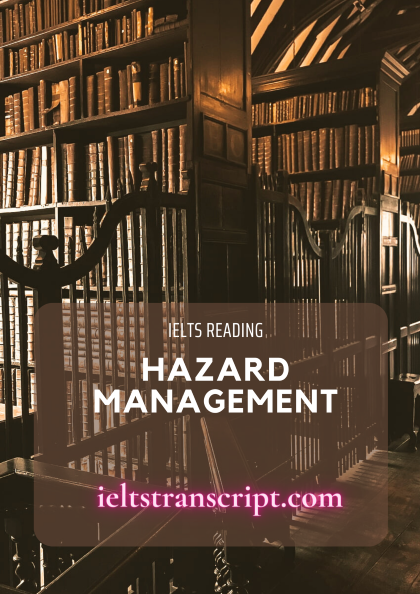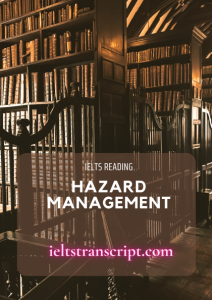- Đối với sản phẩm có giá: Sau khi chúng tôi ghi nhận thông tin đã thanh toán sản phẩm của bạn, sản phẩm sẽ được mở khóa và bạn có thể xem trực tiếp và tải tài liệu sản phẩm.
- Đối với thành viên trả phí: Bạn có thể mua và thanh toán sản phẩm với giá 0đ để tải tài liệu sản phẩm.
- Bạn có thể liên hệ với chúng tôi để được hỗ trợ mở khóa sản phẩm sớm nhất.
HAZARD MANAGEMENT
- Chúng tôi chấp nhận các phương thức thanh toán sau đây: Thẻ tín dụng, thẻ ghi nợ, PayPal, chuyển khoản ngân hàng và tiền mặt.
Chúng tôi sẽ không thu thêm phí cho bất kỳ hình thức thanh toán nào.
- Nếu bạn gặp vấn đề về sản phẩm của chúng tôi trong thời gian sử dụng, vui lòng liên hệ với chúng tôi để được hỗ trợ xử lý sớm nhất nhé.
Xem trước mẫu
HAZARD MANAGEMENT
In many industrial or manufacturing workplaces, managing hazards is essential for a successful health and safety system. Hazard management is an ongoing process that goes through five different stages, with each step becoming a stage on tire hazard management plan.
The first step is to identify potential hazards, remembering that hazards are classed as anything that could potentially cause harm not only to people, but also to the organisation. To illustrate, an industrial accident can cause an injury to employees, but can also result in lost production, broken machinery and wasted resources for the company. In many cases, local and national government legislation has strict regulations concerning hazard identification, and in many industries, especially those perceived to be dangerous, severe penalties can be incurred by companies overlooking such hazard identification.
Having identified the potential hazards, the next step is to assess the hazard; that is, to consider to what extent they are significant. To a degree, this is a subjective aspect of risk management, as what may be seen by one person to be a significant issue can be seen by another to be an acceptable feature of a workplace. To allow for a degree of uniformity, in this stage, hazards are rated using risk assessment tables. These tables work by assigning a point value to three areas. The first is the exposure score, which assesses how often people are exposed to the hazard. If this is a continuous risk which employees face all the time, the score will be high; if the exposure is very rare, the points given will be substantially lower, The score is then multiplied by the likelihood of this hazard causing an injury, ranging from ‘Definite’ (it happens all the time) down to ‘Unlikely’ (it hasn’t happened yet). This is referred to as the chances rating. The sum of the first two scores is again multiplied by the effects score, which considers how serious any accident might be. This can be rated from 1 (requiring minor fist aid) right up to multiple deaths (classed as disaster). All 3 scores then give the final risk assessment result. Generally, a result in excess of 100 points requires caution, but a result of 200 hundred or more is classed as high priority. Certain jobs are, for the most part, permanently gamer scores of over 200 (fire-fighting, for example) and in many cases additional payments, informally known as ‘danger money’, are applied.
The third step on the hazard management plan is to control hazards that have been identified. There are 3 stages to hazard control. The first aim is to eliminate the hazard – that is, to get rid of it altogether. This can be achieved by removing debris or unnecessary obstacles from the workplace. Often, however, this is not possible, so the next step is to isolate the hazard, to store it out of the way. For example, a cleaning company cannot completely eliminate hazardous chemicals, but they can keep these chemicals locked away until required. Isolating hazards is an ongoing process which requires companies to have very dear and enforced guidelines regarding safe storage of potentially hazardous products.
If the hazards cannot be isolated, then the aim must be to minimise the risk. This is achieved through staff training in safe handling techniques and best practices, as well as the provision of personal protection equipment (PPE). PPE commonly includes items such as gloves, overalls and footwear with steel reinforced areas.
The fourth and fifth steps on a hazard management plan are connected – to record and review’ the hazard. The recording is done in the hazard register, and this register is continually reviewed to ensure best practices are maintained. If a severe accident does occur in the workplace, it is the hazard register that investigators often first turn to, to see if the issue had previously been reported and if so what the company bad done about the hazard.
It is worth noting that since more
...QUẢN TRỊ MỐI NGUY HIỂM
Ở nhiều công xưởng công nghiệp hoặc sản xuất, quản lý các mối nguy là công tác cần thiết cho một hệ thống hữu hiệu về an toàn và sức khỏe. Quản lý mối nguy là một quy trình liên tục trải qua năm giai đoạn khác nhau, với mỗi bước là một giai đoạn trong tổng thế kế hoạch quản trị nguy hiểm.
Bước đầu tiên là xác định các mối nguy tiềm ẩn, cần nhớ rằng các mối nguy được xem là bất cứ thứ gì có thể gây hại không chỉ cho con người mà cho cả cơ quan. Ví dụ, một tai nạn công nghiệp có thể gây thương tích cho nhân viên, nhưng cũng có thể làm sản xuất bị trì trệ, máy móc hư hỏng và lãng phí nguồn lực công ty. Nhiều lúc, quy định địa phương và luật pháp nhà nước ban hành các quy tắc nghiêm ngặt về công tác xác định mối nguy, và trong nhiều ngành, đặc biệt là những ngành nghề được phân nhóm nguy hiểm, công ty có thể phải chịu phạt nặng nếu bỏ qua quy trình xác định hiểm nguy.
Sau khi xác định được các mối nguy tiềm ẩn, bước tiếp theo là ước định mối nguy; nghĩa là xem xét chúng nguy hiểm cỡ nào. Ở một mức độ nào đó, đây là một khía cạnh mang tính chủ quan trong quản lý rủi ro, vì một vấn đề có thể được xem là nghiêm trọng với người này nhưng lại có thể là chấp nhận được đối với một người khác. Để phần nào thống nhất quan điểm chung thì trong giai đoạn này, bảng đánh giá rủi ro được sử dụng để ước định các mối nguy hiểm. Bảng này được dùng để chấm ba mục điểm. Đầu tiên là mục tiếp xúc, dùng để đánh giá tần suất con người tiếp xúc với mối nguy hiểm. Cho điểm cao nếu đây là một rủi ro kéo dài liên tục mà nhân viên phải luôn đối mặt; và cho điểm thấp nếu không có nhiều tiếp xúc xảy ra. Sau đó nhân điểm số này với nguy cơ gây thương tích, từ “Chắc chắn” (luôn xảy ra) đến “Không có khả năng xảy ra” (chưa từng xảy ra). Mục này gọi là đánh giá nguy cơ. Nhân tổng của hai điểm số đầu tiên với điểm ảnh hưởng, là điểm đo mức độ nghiêm trọng của bất kỳ tai nạn nào có thể xảy ra. Mục này xếp hạng các rủi ro từ mức 1 (chỉ cần sơ cứu căn bản) cho đến mức chết người hàng loạt (thảm họa). Kết quả đánh giá rủi ro cuối cùng được tổng kết từ cả 3 mục điểm trên. Nói chung, cần thận trọng nếu tổng điểm vượt quá 100, và cần đặc biệt ưu tiên nếu kết quả từ 200 điểm trở lên. Với một số ngành nghề nhất định, điểm số ở hầu hết khía cạnh luôn luôn đạt trên 200 (như lính cứu hỏa), và thường sẽ được hỗ trợ một khoản “trợ cấp nguy hiểm”.
Bước thứ ba trong quy trình quản lý mối nguy là kiểm soát các mối nguy đã xác định. Có 3 giai đoạn kiểm soát mối nguy. Mục tiêu đầu tiên là loại bỏ các mối nguy này – tức là loại bỏ hoàn toàn mối nguy hiểm. Có thể thực hiện việc này bằng cách dọn sạch các mảnh vỡ hoặc các chướng ngại không cần thiết khỏi nơi làm việc. Tuy nhiên, bước này thường không khả thi, vì vậy bước tiếp theo sẽ là cô lập mối nguy hiểm, tách biệt với xung quanh. Ví dụ, một công ty vệ sinh không thể loại bỏ hoàn toàn các hóa chất độc hại, nhưng các chất này có thể được khóa kín cho đến khi cần. Cô lập các mối nguy là một quá trình liên tục đòi hỏi các công ty phải đưa ra bộ quy trình hướng dẫn rất chặt chẽ và hiệu quả cho công tác bảo quản các sản phẩm tiềm ẩn nguy hiểm một cách an toàn.
Nếu không thể cô lập các mối nguy hại, mục tiêu cần đạt ít nhất là giảm thiểu rủi ro nguy hiểm. Tiến hành bằng việc đào tạo đội ngũ nhân viên các khóa kỹ năng và thực hành xử lý an toàn, cũng như cung cấp thiết bị bảo vệ cá nhân (PPE). PPE thường bao gồm các vật dụng như găng tay, áo bảo hộ toàn thân và giày bảo hộ dán thép.
Bước thứ tư và thứ năm trong quy trình quản lý mối nguy đi cùng với nhau – ghi chép và tái duyệt mối nguy. Ghi chép cần được thực hiện trong sổ liệt kê nguy cơ và sổ liệt kê này cần được liên tục xem xét để đảm bảo duy trì các biện pháp xử lý tốt nhất. Nếu tai nạn nghiêm trọng xảy ra tại nơi làm việc, nhà điều tra sẽ tìm đến sổ liệt kê nguy hiểm đầu tiên, để xem liệu mối nguy này đã được ghi nhận trước đó chưa và nếu có thì công ty đã làm gì để xử lý mối nguy đó.
Đáng chú ý rằng kể từ khi áp dụng nghiêm ngặt các hệ thống quản lý nguy
...Để xem được đầy đủ nội dung và tải dữ liệu, bạn phải trở thành thành viên của chúng tôi và trả phí cho tài liệu (nếu có)












